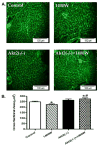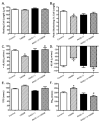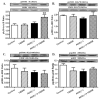Akt2 knockout mitigates chronic iNOS inhibition-induced cardiomyocyte atrophy and contractile dysfunction despite persistent insulin resistance
- PMID: 21964073
- PMCID: PMC3208377
- DOI: 10.1016/j.toxlet.2011.09.015
Akt2 knockout mitigates chronic iNOS inhibition-induced cardiomyocyte atrophy and contractile dysfunction despite persistent insulin resistance
Erratum in
- Toxicol Lett. 2016 Apr 15;247():71-2
Abstract
Increased levels of inducible nitric oxide synthase (iNOS) during cardiac stress such as ischemia-reperfusion, sepsis and hypertension may display both beneficial and detrimental roles in cardiac contractile performance. However, the precise role of iNOS in the maintenance of cardiac contractile function remains elusive. This study was designed to determine the impact of chronic iNOS inhibition on cardiac contractile function and the underlying mechanism involved with a special focus on the NO downstream signaling molecule Akt. Male C57 or Akt2 knockout [Akt2(-/-)] mice were injected with the specific iNOS inhibitor 1400W (2 mg/kg/d) or saline for 7 days. Both 1400W and Akt2 knockout dampened glucose and insulin tolerance without additive effects. Treatment of 1400W decreased heart and liver weights as well as cardiomyocyte cross-sectional area in C57 but not Akt2 knockout mice. 1400W but not Akt2 knockout compromised cardiomyocyte mechanical properties including decreased peak shortening and maximal velocity of shortening/relengthening, prolonged relengthening duration, reduced intracellular Ca(2+) release and decay rate, the effects of which were ablated or attenuated by Akt2 knockout. Akt2 knockout but not 1400W increased the levels of intracellular Ca(2+) regulatory proteins including SERCA2a and phospholamban phosphorylation. 1400W reduced the level of anti-apoptotic protein Bcl-2, the effect of which was unaffected by Akt2 knockout. Neither 1400W nor Akt2 knockout significantly affected ER stress, autophagy, the post-insulin receptor signaling Akt, GSK3β and AMPK, as well as the stress signaling IκB, JNK, ERK and p38 with the exception of elevated IκB phosphorylation with jointed effect of 1400W and Akt2 knockout. Taken together, these data indicated that an essential role of iNOS in the maintenance of cardiac morphology and function possibly through an Akt2-dependent mechanism.
Copyright © 2011 Elsevier Ireland Ltd. All rights reserved.
Figures








Similar articles
-
Short-chain fatty acid propionate alleviates Akt2 knockout-induced myocardial contractile dysfunction.Exp Diabetes Res. 2012;2012:851717. doi: 10.1155/2012/851717. Epub 2011 Sep 22. Exp Diabetes Res. 2012. PMID: 21960994 Free PMC article.
-
Inhibition of CYP2E1 attenuates myocardial dysfunction in a murine model of insulin resistance through NLRP3-mediated regulation of mitophagy.Biochim Biophys Acta Mol Basis Dis. 2019 Jan;1865(1):206-217. doi: 10.1016/j.bbadis.2018.08.017. Epub 2018 Aug 16. Biochim Biophys Acta Mol Basis Dis. 2019. PMID: 30463689
-
Hydrogen sulfide alleviates cardiac contractile dysfunction in an Akt2-knockout murine model of insulin resistance: role of mitochondrial injury and apoptosis.Am J Physiol Regul Integr Comp Physiol. 2014 May 15;306(10):R761-71. doi: 10.1152/ajpregu.00327.2013. Epub 2014 Mar 12. Am J Physiol Regul Integr Comp Physiol. 2014. PMID: 24622975 Free PMC article.
-
Ablation of Akt2 protects against lipopolysaccharide-induced cardiac dysfunction: role of Akt ubiquitination E3 ligase TRAF6.J Mol Cell Cardiol. 2014 Sep;74:76-87. doi: 10.1016/j.yjmcc.2014.04.020. Epub 2014 May 5. J Mol Cell Cardiol. 2014. PMID: 24805195 Free PMC article.
-
mTOR-Independent autophagy inducer trehalose rescues against insulin resistance-induced myocardial contractile anomalies: Role of p38 MAPK and Foxo1.Pharmacol Res. 2016 Sep;111:357-373. doi: 10.1016/j.phrs.2016.06.024. Epub 2016 Jun 27. Pharmacol Res. 2016. PMID: 27363949 Free PMC article.
Cited by
-
Targeted deletion of PTEN in cardiomyocytes renders cardiac contractile dysfunction through interruption of Pink1-AMPK signaling and autophagy.Biochim Biophys Acta. 2015 Feb;1852(2):290-8. doi: 10.1016/j.bbadis.2014.09.002. Epub 2014 Sep 16. Biochim Biophys Acta. 2015. PMID: 25229693 Free PMC article.
-
Contractile Activity Regulates Inducible Nitric Oxide Synthase Expression and NO(i) Production in Cardiomyocytes via a FAK-Dependent Signaling Pathway.J Signal Transduct. 2012;2012:473410. doi: 10.1155/2012/473410. Epub 2012 Jul 26. J Signal Transduct. 2012. PMID: 22900166 Free PMC article.
-
RETRACTED: Akt2 knockout alleviates prolonged caloric restriction-induced change in cardiac contractile function through regulation of autophagy.J Mol Cell Cardiol. 2014 Jun;71:81-91. doi: 10.1016/j.yjmcc.2013.12.010. Epub 2013 Dec 22. J Mol Cell Cardiol. 2014. Retraction in: J Mol Cell Cardiol. 2023 Apr;177:63. doi: 10.1016/j.yjmcc.2023.03.005. PMID: 24368095 Free PMC article. Retracted.
-
Folic acid reverses nitric oxide synthase uncoupling and prevents cardiac dysfunction in insulin resistance: role of Ca2+/calmodulin-activated protein kinase II.Free Radic Biol Med. 2013 Dec;65:234-243. doi: 10.1016/j.freeradbiomed.2013.06.042. Epub 2013 Jun 29. Free Radic Biol Med. 2013. PMID: 23820268 Free PMC article.
-
TRIB3 regulates FSHR expression in human granulosa cells under high levels of free fatty acids.Reprod Biol Endocrinol. 2021 Sep 9;19(1):139. doi: 10.1186/s12958-021-00823-z. Reprod Biol Endocrinol. 2021. PMID: 34503515 Free PMC article.
References
-
- Bai-Feng L, Yong-Feng L, Ying C. Silencing inducible nitric oxide synthase protects rat pancreatic islet. Diabetes Res Clin Pract. 2010;89:268–275. - PubMed
-
- Carvalho-Filho MA, Ueno M, Hirabara SM, Seabra AB, Carvalheira JB, de Oliveira MG, Velloso LA, Curi R, Saad MJ. S-nitrosation of the insulin receptor, insulin receptor substrate 1, and protein kinase B/Akt: a novel mechanism of insulin resistance. Diabetes. 2005;54:959–967. - PubMed
-
- Ceriello A, Quagliaro L, D’Amico M, Di Filippo C, Marfella R, Nappo F, Berrino L, Rossi F, Giugliano D. Acute hyperglycemia induces nitrotyrosine formation and apoptosis in perfused heart from rat. Diabetes. 2002;51:1076–1082. - PubMed
-
- Cho H, Mu J, Kim JK, Thorvaldsen JL, Chu Q, Crenshaw EB, 3rd, Kaestner KH, Bartolomei MS, Shulman GI, Birnbaum MJ. Insulin resistance and a diabetes mellitus-like syndrome in mice lacking the protein kinase Akt2 (PKB beta) Science. 2001;292:1728–1731. - PubMed
-
- De Meyer GR, De Keulenaer GW, Martinet W. Role of autophagy in heart failure associated with aging. Heart Fail Rev. 2010;15:423–430. - PubMed
Publication types
MeSH terms
Substances
Grants and funding
LinkOut - more resources
Full Text Sources
Research Materials
Miscellaneous

